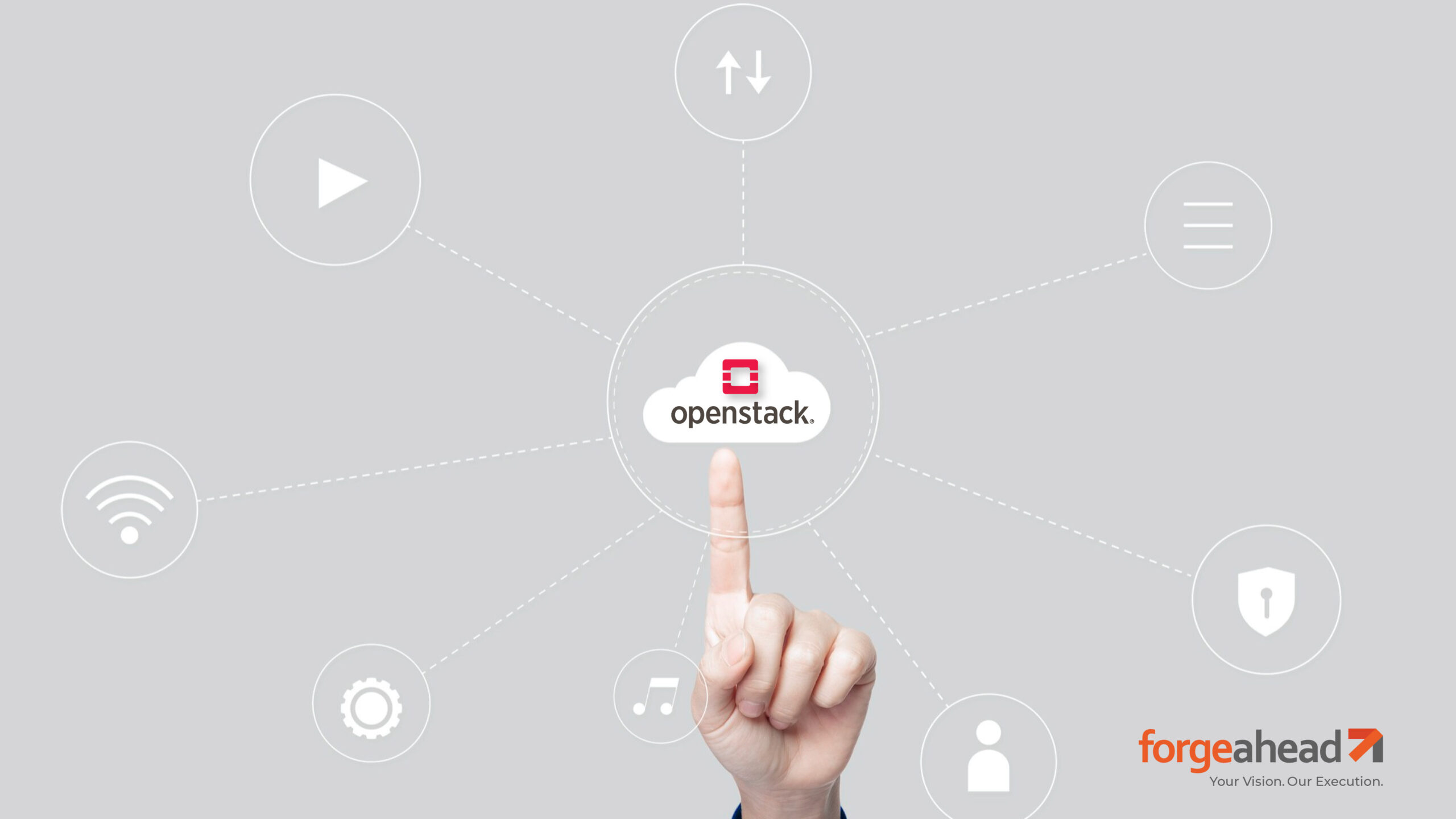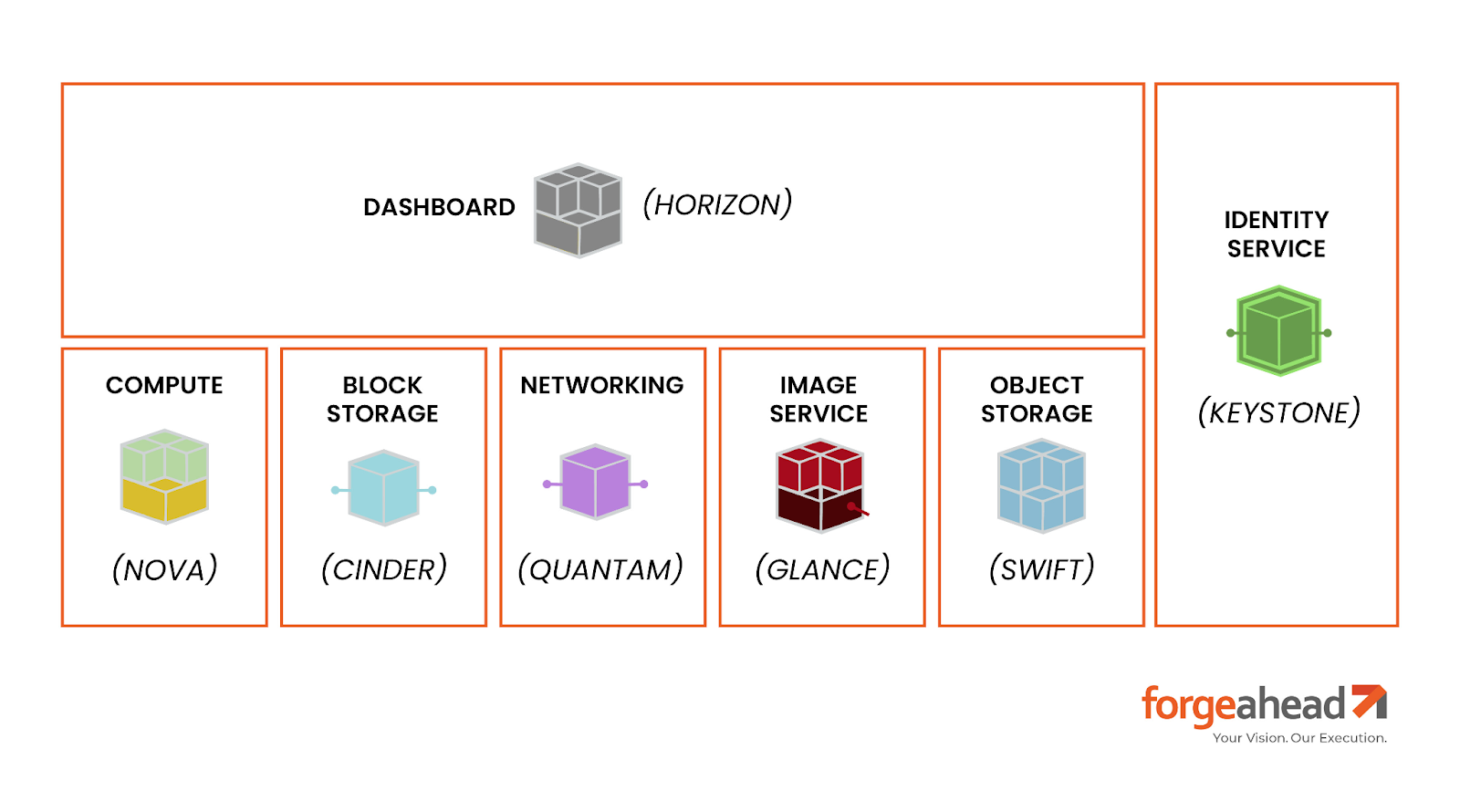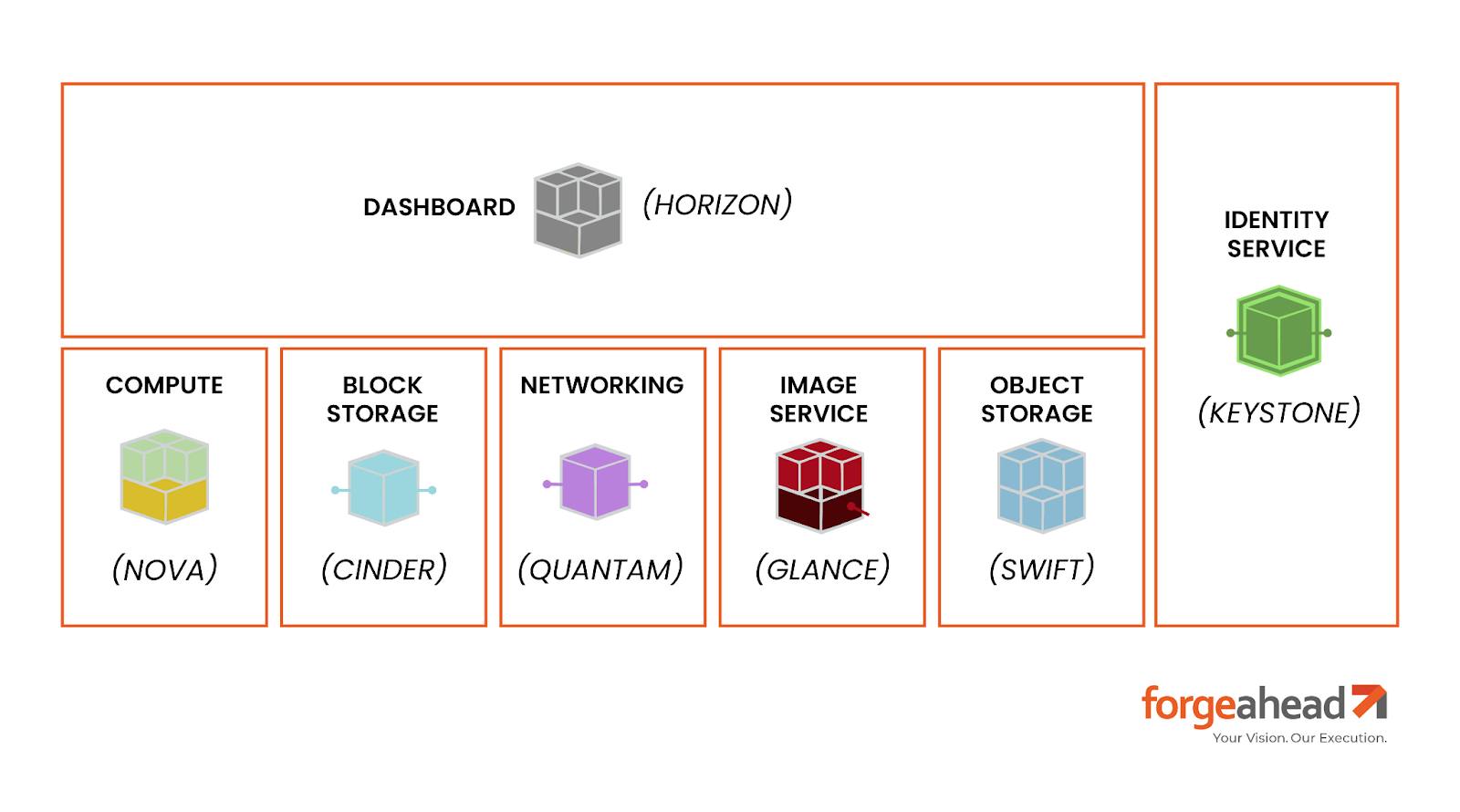Introduction to OpenStack Cloud Infrastructure
OpenStack is an open-source cloud computing platform that provides Infrastructure as a Service (IaaS).
It consists of interrelated components that control diverse hardware pools of processing, storage, and networking resources throughout a data center.
The core components include Nova (compute), Swift (object storage), Cinder (block storage), Neutron (networking), and Keystone (identity service).
History and Evolution
OpenStack was initiated in 2010 as a joint project by NASA and Rackspace. Over the years, it has evolved with contributions from a vast global community of developers and IT companies.
Today, it is a leading open-source cloud platform, supported by the OpenStack Foundation.
Use Cases of OpenStack
OpenStack is widely used across various industries for diverse applications, including:
- Telecommunications: Powering network functions virtualization (NFV)
- Research: Enabling scalable computing for complex simulations
- Finance: Providing secure and flexible infrastructure for financial services
- E-commerce: Supporting scalable and resilient online retail platforms
Benefits of OpenStack Cloud Infrastructure
Cost-Effective Solutions
OpenStack significantly reduces costs by utilizing open-source software. This eliminates licensing fees, allowing businesses to allocate funds towards infrastructure and innovation instead of costly software licenses.
Flexibility and Scalability
OpenStack offers unmatched flexibility and scalability, enabling organizations to adjust their infrastructure seamlessly based on demand. Its modular architecture ensures efficient resource usage, making it ideal for both expanding operations and scaling down as needed.
Community Support and Innovation
The robust OpenStack community of global developers and contributors drives continuous innovation and provides strong support. This collaborative environment ensures the platform remains cutting-edge, benefiting from ongoing improvements and best practices.
Enhanced Security
OpenStack provides advanced security features, including role-based access control (RBAC), network isolation, and encrypted communications. This helps protect sensitive data and maintain compliance with industry standards.
Interoperability
OpenStack’s open standards and APIs facilitate seamless integration with various third-party tools and services. This interoperability ensures that organizations can easily incorporate OpenStack into their existing IT ecosystems.
Automation and Orchestration
OpenStack includes powerful tools for automation and orchestration, such as Heat and TripleO. These tools simplify the deployment, management, and scaling of cloud resources, improving operational efficiency.
Vendor Neutrality
Being an open-source platform, OpenStack avoids vendor lock-in, providing organizations with the flexibility to choose their preferred hardware and software vendors. This promotes a competitive marketplace and allows businesses to select the best solutions for their needs.
Deploying OpenStack: A Step-by-Step Guide
Planning and Preparation
Before deploying OpenStack, thorough planning and preparation are crucial. Assess hardware requirements, including servers, storage, and networking equipment. Ensure network planning covers aspects like IP addressing, VLANs, and bandwidth allocation.
Installation Options for OpenStack
OpenStack offers various installation methods:
- Manual Installation: Suitable for custom setups, providing granular control over each component
- Automated Tools: Tools like DevStack streamline installation for development and testing environments
- Commercial Distributions: Providers like Red Hat or Canonical offer supported OpenStack distributions, simplifying deployment for enterprise environments
Configuration
Initial configuration is vital for optimal performance. Set up the control plane, including components like Keystone (identity service) and Horizon (dashboard).
Configure compute, storage, and networking services, ensuring each is tailored to your specific needs.
Follow best practices such as enabling security features, setting resource quotas, and implementing monitoring tools.
Steps for Integrating OpenStack with Existing Systems
- Evaluate Current Infrastructure: Conduct a thorough assessment of your existing IT systems to ensure hardware and software compatibility with OpenStack. Identify any potential conflicts or requirements for upgrades
- Plan Integration Points: Determine where OpenStack will interact with current systems. Common integration points include storage, networking, and identity management services
Leveraging APIs and Interfaces
- Use OpenStack APIs: OpenStack offers APIs for compute (Nova), storage (Cinder, Swift), and networking (Neutron). Utilize these APIs to automate and manage cloud resources
- Integrate with Existing Tools: Implement APIs to connect OpenStack with existing management tools like Kubernetes for container orchestration or VMware for virtualization
Hybrid Cloud Strategies
- Set Up Hybrid Cloud: Use OpenStack to create a private cloud that integrates with public clouds like AWS, Azure, or Google Cloud
- Manage Workloads: Distribute workloads between private and public clouds based on performance, security, and cost considerations. Tools like OpenStack Heat (orchestration) can help manage and automate these processes
Example Process for Integration
- Compatibility Check: Run compatibility tests on current infrastructure
- API Setup: Configure OpenStack APIs to interact with existing systems
- Hybrid Cloud Configuration: Set up and test hybrid cloud environments, ensuring smooth workload distribution
By following these steps, businesses can seamlessly integrate OpenStack with their existing systems, enhancing flexibility and operational efficiency.
Performance Optimization in OpenStack
Resource Management
Efficient resource management is crucial for optimal performance. Utilize OpenStack’s capabilities to balance compute, storage, and networking resources:
- Compute: Use Nova to manage and allocate virtual machines (VMs) based on workload requirements
- Storage: Optimize storage resources with Cinder for block storage and Swift for object storage, ensuring data is stored and retrieved efficiently
- Networking: Implement Neutron to configure and manage network resources, ensuring minimal latency and high throughput
Monitoring and Maintenance
Continuous monitoring and regular maintenance are vital for maintaining performance. Here are some tools and techniques:
- Ceilometer: Provides telemetry data for monitoring resource usage and performance
- Zabbix and Nagios: Robust infrastructure monitoring tools that offer insights into system health, performance metrics, and alerting mechanisms
- Grafana and Prometheus: Use Grafana for visualization and Prometheus for monitoring metrics, offering a comprehensive view of system performance
- Log Management: Implement log management tools like ELK Stack (Elasticsearch, Logstash, Kibana) to analyze and visualize logs for troubleshooting and performance analysis
- Automated Maintenance: Use configuration management tools like Ansible, Puppet, or Chef to automate regular maintenance tasks, updates, and patches, ensuring the environment remains secure and efficient
Scalability
Scalability is essential for meeting growing demands:
- Horizontal Scaling: Add more nodes to the OpenStack cluster to handle increased workloads. Use Nova’s scaling capabilities to distribute VMs efficiently
- Load Balancing: Implement load balancers to distribute traffic evenly across the infrastructure, ensuring no single node becomes a bottleneck
- Auto-Scaling: Utilize Heat, OpenStack’s orchestration tool, to automatically adjust resources based on real-time demand, ensuring optimal performance during peak times
Compliance in OpenStack
OpenStack Built-in Security Features
OpenStack comes with a robust set of built-in security features designed to protect cloud environments:
- Keystone: Provides centralized authentication and authorization, ensuring secure access to resources
- Role-Based Access Control (RBAC): Manages user permissions based on roles, limiting access to sensitive data and functions
- Security Groups: Defines firewall rules to control inbound and outbound traffic for instances, enhancing network security
- Network Isolation: Uses Neutron to create isolated networks for different tenants, preventing unauthorized access
- SSL/TLS Encryption: Ensures secure communication between services and clients by encrypting data in transit
- Audit Logs: Keeps detailed logs of user activities and API calls, facilitating auditing and forensic analysis
- Image Signing and Verification: Verifies the integrity and authenticity of VM images using cryptographic signatures
- Ephemeral Storage Encryption: Protects data stored in ephemeral volumes by encrypting it at rest
Compliance Standards
Ensuring compliance with industry standards and regulations is crucial for maintaining trust and legal standing. OpenStack supports various compliance measures:
- GDPR: Implements data protection measures to comply with the General Data Protection Regulation
- HIPAA: Adheres to health data privacy and security regulations to ensure compliance with the Health Insurance Portability and Accountability Act
- PCI-DSS: Follows guidelines for processing and storing credit card information securely
Incident Response
Preparing for and responding to security incidents is a vital part of maintaining a secure cloud environment:
- Incident Detection: Utilize monitoring tools to detect potential security breaches and anomalies in real-time
- Response Plan: Develop and regularly update an incident response plan that outlines the steps to take during a security event
- Forensic Analysis: Conduct thorough investigations using audit logs and other tools to understand the incident’s impact and prevent future occurrences
- Recovery Procedures: Implement robust recovery procedures to restore normal operations quickly after an incident
Best Practices for Managing OpenStack
Governance
Establishing robust governance policies is essential for effective OpenStack management:
- Policy Framework: Develop a clear governance framework that defines roles, responsibilities, and processes for managing OpenStack
- Compliance: Ensure adherence to industry standards and internal policies through regular audits and monitoring
Automation
Leveraging automation tools can streamline deployment, scaling, and management:
- Deployment Automation: Use tools like Ansible, Puppet, and Chef to automate the setup and configuration of OpenStack environments
- Scaling Automation: Implement auto-scaling policies using OpenStack Heat or Kubernetes to handle varying workloads efficiently
Training and Development
Investing in training ensures your team can manage and optimize OpenStack effectively:
- Continuous Learning: Provide ongoing training and certification opportunities for your IT staff
- Knowledge Sharing: Encourage knowledge sharing and collaboration through regular team meetings and participation in OpenStack community events
By following these best practices, organizations can enhance their OpenStack management, ensuring efficiency, compliance, and optimal performance.
Maximize Your OpenStack Potential
In this blog, we’ve explored the benefits and intricacies of OpenStack cloud architecture, from deployment and integration to performance optimization and security compliance.
OpenStack offers a cost-effective, flexible, and scalable solution for managing cloud environments, supported by a robust community and innovative features.
Ready to transform your cloud infrastructure with OpenStack?
Contact Forgeahead today for expert guidance and support in deploying and managing your OpenStack environment. Let us help you navigate the complexities and maximize the benefits of this powerful open-source cloud platform.





